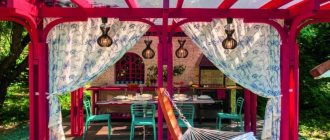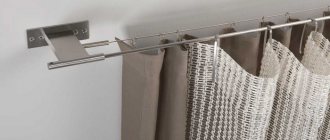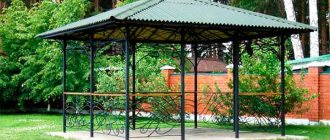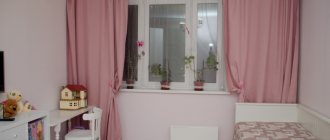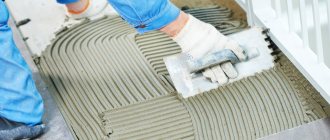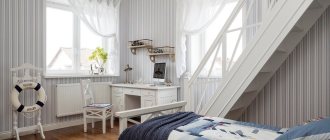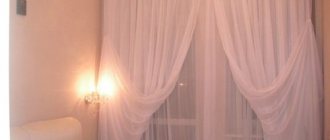Functions of outdoor curtains
In addition to their decorative role, curtains perform several other important functions in the design of gazebos:
- Protection from natural phenomena (sun, rain, hail, strong wind);
- Protection from mosquitoes and other insects;
- Protecting the furniture and decor of the gazebo from moisture and dirt;
- Maintaining temperature;
- Confidentiality. Colored or thick curtains will reliably hide you and your guests from prying eyes.
Textile curtains
Fabric curtains for gazebos and verandas are primarily decor. Textile curtains are unraveled or tied to the posts of the gazebo. Typically, curtains are also made in translucent fabrics such as tulle or organza. Thin fabric protects owners from prying eyes, insects, excessively bright sun and allows air to pass through well. At the same time, it will be useless in heavy rain or gusts of wind.
The main advantage of soft curtains for gazebos is their low price and ease of installation. To sew curtains, you can use fabrics that are denser than tulle. In this case, it is better to give preference to natural fabrics that allow air to pass through well.
Veranda design ideas
Using curtains to design a summer veranda allows you to place accents in the room and set the direction for the overall style. Various fabric products will give the building a romantic look and aesthetics, while more practical models will create a quiet and peaceful environment.
The photo shows a veranda decorated with dark-colored outdoor roller blinds.
Acrylic curtains
It will be more practical to use acrylic as a fabric for curtains in a gazebo. Acrylic curtains are easy to clean, are not afraid of water, and can easily protect owners from the sun, rain and insects. Acrylic fabric practically does not allow air to pass through. In the summer this can be a problem, but in the spring and autumn this property will come in handy. If you lower such curtains and turn on the heater, the warmth will remain in the gazebo and will not allow you to freeze even in the most chilly weather.
Among other things, acrylic can withstand both severe frost and tropical heat and does not deform in any way.
Photo examples for gazebos
Plain curtains or curtains with various prints fit perfectly into the surrounding landscape design, create a mood and make the room bright. Light curtains are especially suitable for decorating a wooden gazebo.
The photo shows transparent orange curtains in a summer gazebo.
Impregnated curtains
An alternative option could be textile curtains with special Teflon impregnation. Natural fabrics are usually impregnated with a protective composition. As a result, they retain their appearance, remain soft and breathable, but at the same time are not afraid of water and dirt, and are easy to wash.
Such curtains will become a real decoration for your gazebo or veranda, but you will have to pay several times more for them than for ordinary textile or acrylic curtains.
If you like one of the above fabrics, you can sew curtains from them yourself without resorting to the services of a seamstress.
Terrace design options
Models of the simplest configuration fit harmoniously into the overall exterior, decorate it with their appearance and perfectly perform practical functions.
The photo shows a terrace with bright outdoor curtains.
Materials and tools for sewing fabric curtains
To sew curtains with your own hands, you need to prepare:
- The right amount of fabric. The material can be used natural or synthetic according to your desire;
- Metal eyelet rings;
- Scissors;
- Metal fastenings;
- Synthetic twine;
- Long ruler;
- Pencil or felt-tip pen for marking;
- A needle;
- Threads;
- Sewing machine.
Master class on sewing curtains
- Measure in advance the width and height of each opening you want to close. You need to buy the material with a small supply. Curtains for an outdoor gazebo can be made from any material, but if you are planning rain curtains for a gazebo, it is better to buy acrylic or PVC fabric;
- Iron regular fabric thoroughly;
- Draw a pattern of future parts on the fabric;
- Cut out the pattern;
- If the edges of the fabric are fraying, fold them twice by 2 cm and stitch them on a sewing machine;
- To ensure that the curtains have uniform folds, install eyelet rings at the top of each panel at an equal distance from each other;
- At the top of the gazebo or veranda, above the opening where the curtains will hang, attach anchors;
- Pass the twine through the eyelets on the curtain and secure both ends to the anchors;
- You can also use curtain tape as a fastening if you are using light fabric or sew on textile loops.
Blinds
This option can have both horizontal and vertical arrangement of elements. For outdoor use, blinds must be made of stainless steel or aluminum. When planning to make blinds yourself, you should take into account that the strips they are made of have a curved shape.
An excellent option that allows you to completely close and even lock the gazebo are roller shutters. They are ordered ready-made, and installation is easy to do on your own. To do this, you will need to secure the top box and horizontal guides.
PVC curtains
PVC curtains for gazebos are also very popular. Polyvinyl chloride perfectly protects the gazebo from even heavy rain and wind. Such curtains can be colored or patterned. Often cottage owners choose transparent curtains for gazebos; transparent PVC protects the veranda well and does not block the beautiful view.
The only drawback of PVC curtains is their absolute airtightness. If acrylic allows air to pass through, but poorly, then PVC makes it even worse. A gazebo with such curtains must be ventilated frequently or one of the curtain sections must be left open. Otherwise, guests will definitely begin to feel dizzy from lack of oxygen.
Be responsible when choosing the density of curtain material
Here it is important to consider which side the windows from the room are facing: sunny or shaded. The choice of material depends on this. For the sunny side, thicker curtains are good. Since in hot weather it will be easier to keep the indoors cool and fresh.
For the shaded side, it is better to choose light and airy tulles or curtains. In this case, warm street air will easily penetrate into your room.
DIY PVC curtains
Working with PVC film is very easy. You can make curtains for your gazebo yourself. For this you will need:
- PVC fabric;
- Metal eyelets;
- Special fastenings for PVC;
- Scissors;
- Synthetic rope.
Note!
- DIY metal bench: instructions with step-by-step guide (100 photo ideas)
Blinds for gazebos: wooden, metal, bamboo. Instructions for installing blinds yourself
- Adding a terrace to your house with your own hands: step-by-step instructions on how to easily and quickly add a veranda or terrace (100 design photos)
The creation of curtains occurs in the following sequence:
- Cut the fabric into sheets. Each canvas should be equal to the width of the span between the posts; the length of the canvas should not reach the floor 10 cm;
- Attach a grommet to the corners of each canvas;
- Attach anchors to the posts to which the curtain fastening will cling;
- Pull a piece of rope through the eyelets and secure it to the appropriate anchor, repeat for each eyelet.
Advice for needlewomen
In addition to the popular Roman curtains, the ready-made patterns of which make it easy to sew curtains for the veranda, there are more creative approaches that allow you to create curtains for the veranda yourself. This could be, for example, scraps of fabric of different densities and textures, sewn into a single piece, leaves from plastic bottles, or wooden parts strung on a cord. A creative approach and inventive resourcefulness will help make your favorite terrace original and unique.
Advice from experienced craftswomen!
Having decided to decorate the area of a terrace, veranda or gazebo with curtains, it is recommended to study and become familiar with the existing photo exhibition in advance, using various Internet resources in order to obtain complete information about existing models, their advantages and disadvantages.
Curtains for verandas and terraces, which everyone can afford, will help you escape from the bustle of the city, reunite with nature and contemplate the delights of the world around you.
© 2022 textiletrend.ru
Roller blinds
Gazebo roller blinds are also popular for decorating outdoor spaces. Such curtains are most often made from synthetic polyester impregnated with PVC, but roller blinds are also available from other materials (acrylic, linen, bamboo). A curtain is a wide piece of fabric (usually the width of the span), which, when the cord is pulled, is wound around a round shaft located at the bottom of the curtain.
The structure is attached to the top of the gazebo or veranda, under the roof. Roller blinds can be fastened using Velcro or self-tapping screws. The second option is more reliable and preferable for the veranda; in case of strong wind, the Velcro may not hold up and the curtain will fall off.
If the fabric of purchased roller blinds wears out or just gets boring, you can remove it from the shaft and use a glue gun to attach any other fabric of a suitable size.
Decide on a style
Let's look at the example of three main styles that are suitable for any dacha. They all create a warm, comfortable atmosphere in their own way. These styles include country, eco-style and Provence.
Rafblinds
Rafblinds are metal or wooden blinds that are attached to the outside of a gazebo or veranda. A gazebo with rainblinds will be reliably protected from bright sunlight. Also, such curtains provide good sound insulation. The edges of each strip on such blinds are made rounded, this is necessary so that during rain water does not accumulate on the curtains, but flows down. Metal blinds are made of stainless steel, and wooden ones are impregnated with a special moisture-resistant composition.
Country
Country is a version of the rustic style, which includes checkered and floral designs. Such models are sewn up to the middle of the window or to the window sill. This style features cute ruffles and tiebacks on both sides.
In city apartments it will look harmonious and beautiful only in the kitchen, but in the countryside such curtains will look good in any room without exception. From fabrics you need to choose chintz, cotton, linen or cambric.
Curtain fastening methods
There are several popular methods for attaching curtains, including outdoor ones.
Curtain tape. Ready-made tape per meter is purchased at sewing stores. The ribbon needs to be sewn to the top edge of the curtain. You can pull it up using special laces at the ends, then it will lie in folds. These folds will be repeated by the curtain and then you will not need to lay it out figuratively every time you open the curtains. Hooks for attaching curtains are inserted into the loops on the tape.
Note!
- How to attach a veranda to your house with your own hands - step-by-step instructions from A to Z + photos of new designs
Do-it-yourself columnar foundation for a gazebo: detailed instructions from A to Z + photo
DIY economy class garden gazebo - instructions on how to build quickly and cheaply. Photos, diagrams, drawings, layout and design
Eyelets. Before installing the metal rings, regular fabric must be folded to the width of the eyelet + 3 cm. Next, the places for future fastenings are marked on the fabric. The metal ring needs to be attached to the fabric, circled around it from the inside and cut out a circle. Next, one half of the eyelet is placed under the fabric, the second is placed on top. You need to press the halves until they click.
Textile loops. Large loops made from the same fabric as the curtains can also be used as curtain fastenings. To do this, cut out rectangles measuring 5 by 30 cm from the base material, leaving 1 cm for hem on each side. Having hemmed the rectangle on all sides, fold it in half, fold the ends of the loop together and sew it to the top of the curtain.
Kuliska. This method is used for lightweight fabrics. The main curtain fabric is folded at the top to form a pocket. A fastening rope is threaded through this pocket and folds are formed.
Magnets. In textile stores you can find special magnets for curtains. They are a two-piece design. One is a magnet with a ring attached, the second is a decoratively decorated magnet. The curtain fabric is inserted between two magnets. The base string is threaded through all the rings with magnets and secured to the bracket, then the curtain is applied to one magnet and pressed with the second, this is repeated for each ring.
If you want to use light fabric as curtains, but are worried that the wind will flutter all the time, make another row of fastenings at the bottom of the curtains. The warp thread can be secured along the floor and the bottom row of fastenings can be threaded through it (eyelets are best for this). This way, the curtain will be secured on both sides and the wind will not be able to lift it.
Note!
- Do-it-yourself garden path using a mold: a review of original and inexpensive ideas + step-by-step instructions with photos
- Do-it-yourself gazebos for a summer residence - 300 photos of exclusive ideas. Instructions for building a beautiful gazebo (diagrams, drawings, foundation, roof)
- How to insulate a veranda for winter living: floor, ceiling, walls. Examples of insulation from the inside and outside (instructions + photos)
Curtains for a gazebo or open veranda are not only beautiful, but also a very practical accessory. Curtains made from thin natural fabrics will make your gazebo light and elegant, while dense modern materials will reliably protect you from bad weather. Ready-made curtains can be purchased at the store, or you can make them yourself. In this case, your curtains will definitely be exclusive. Moreover, sewing outdoor curtains will not be difficult.
Color
When choosing curtains for an extension, it is important to pay attention not only to the material. Color matters too. Neutral options that suit most interiors are plain canvases in light, pastel or sand tones. It is good to choose bright curtains when the decor of the garden and the terrace itself already has contrasting objects. By the way, flower beds can also serve as such objects. For an interior or landscape with an oriental flavor, not only bamboo curtains are suitable, but also options with prints in the same style. Add wooden lanterns to the interior and place small figurines around the garden - you will get a harmonious unity of the interior and exterior.
Kauffort Avery set with braid 280 cm
A terrace and veranda are always close to nature, which means any natural motifs will come in handy. Take a closer look at country-style curtains - they are usually made from natural fabrics in pastel colors. Plain items made of cotton, chintz and linen, or with a print, will add coziness, warmth to the interior of the veranda and create a relaxing atmosphere. You can arm yourself with tiebacks and drape the curtains into cute folds along the edges of the window.
Instagram @designer_marina
Instagram @designer_marina
Instagram @designer_marina
Curtains for an open veranda, as a rule, are chosen in light shades so that they do not draw attention to themselves and do not overload the design of the area. It is best to rely on a beige palette - it is universal.
Instagram @shtory_ufa_hygge
Instagram @veter.olga.1976
